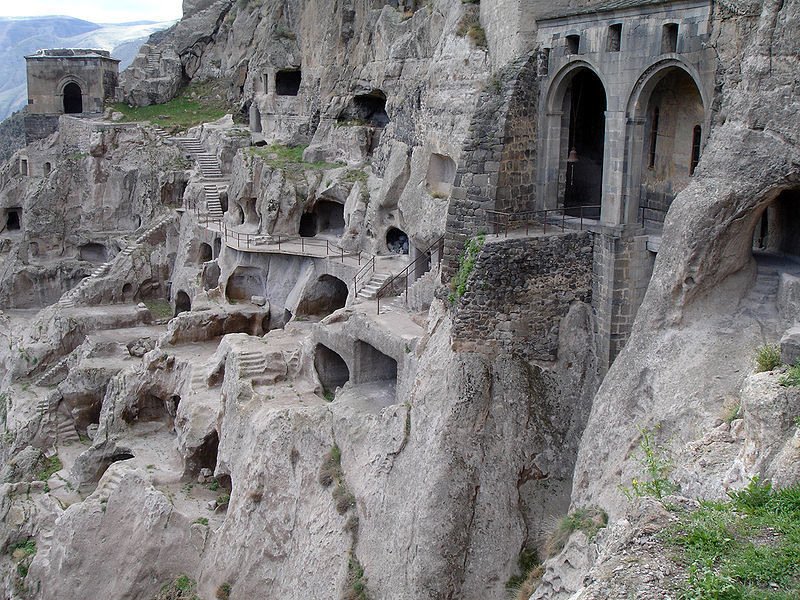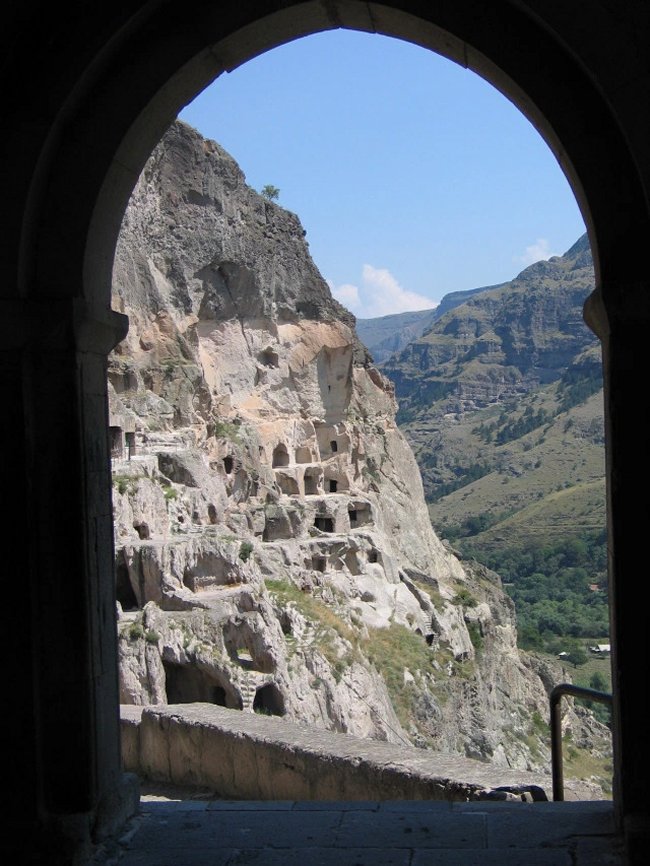Spectacular Vardzia Cave Monastery – Huge Underground Complex Founded By The ‘Mountain Queen’ Tamar
Ellen Lloyd - AncientPages.com - The only way to get to this spectacular and huge underground city was via well-hidden tunnels which started at the nearby Mtkvari river.
The cave city of Vardzia is a monastery complex dug into the side of the Erusheli Mountain in southern Georgia near Aspindza.
Five monks still live in this mountain. Every morning at seven they ring the bell in the high arch. Image credit: ben van der ploeg - CC BY 2.0
Founded in 1185 by Queen Tamar it served as a protection of the fearsome and brutal Mongols who slaughtered people at the time.
Queen Tamar who was crowned “King” was the most famous woman in Georgian history
Queen Tamara (1169-1212), who reigned from 1184 to 1212 ruled over the largest territory ever to come under the control of Georgia; during her reign, the kingdom stretched from Azerbaijan, north of present-day Iran, to the borders of Cherkessia, in the North Caucasus.
The prosperity of Georgia to the Board - Queen Tamar. Image credit: Caucasuspress - CC BY-SA 4.0
Queen Tamar was enthroned as ruler of Georgia at the age of eighteen. She was called “King” because her father had no male heir and so she ruled as a monarch and not as a consort.
Tamar was married twice, her first union being, from 1185 to 1187, to the Rus' prince Yuri, whom she divorced and expelled from the country, defeating his subsequent attempts at a coup. For her second consort, Tamar chose, in 1191, the Alan prince David Soslan, by whom she had two children, George and Rusudan, the two successive monarchs on the throne of Georgia.
Tamar's association with the period of political and military successes and cultural achievements, combined with her role as a female ruler, has led to her idealization and romanticization in Georgian arts and historical memory. She remains an important symbol in Georgian popular culture and has been canonized by the Georgian Orthodox Church as the Holy Righteous King Tamar.
The huge cave monastery complex
The Vardzia monastery consisted of over six thousand apartments in a thirteen-story complex. The city included a church, a throne room, and a complex irrigation system watering terraced farmlands. A complex irrigation system watering terraced farmlands was also constructed and in some tunnels, the old irrigation pipes still bring drinkable water.
Image credit: GeorgiaAbout.com
The glorious days of Vardzia did not last for very long. This magnificent place was never destroyed by the Mongols, but Mother Nature was not kind to the caves. Less than one hundred years after the Vardzia monastery was built a powerful earthquake in 1283 caused two-thirds of the cave system to collapse.
Despite this disaster, the monastery continued until 1551 but was then attacked and pillaged by the Persian Sash Tahmasp who killed all of the monks. It was then that Vardzia was finally abandoned.
In modern days, the monastery is maintained by a small group of zealous monks and there is a growing desire to save this significant and beautiful place.
The monastery can be visited by tourists for a small fee, but if you go there make sure you don’t suffer from claustrophobia because the narrow tunnels and confined spaces might make the visit an uncomfortable experience.
Written by - Ellen Lloyd – AncientPages.com
Copyright © AncientPages.com All rights reserved. This material may not be published, broadcast, rewritten or redistributed in whole or part without the express written permission of AncientPages.com
Expand for referencesReferences:
Georgia About - The Cave City Of Vardzia
More From Ancient Pages
-
 Mysterious Grave Of King Valdemar IV Atterdag – Will The 600-Year-Old Historical Puzzle Ever Be Solved?
Featured Stories | Jul 14, 2018
Mysterious Grave Of King Valdemar IV Atterdag – Will The 600-Year-Old Historical Puzzle Ever Be Solved?
Featured Stories | Jul 14, 2018 -
 Mysterious Books With Dangerous Secret Knowledge Deliberately Hidden From Public View
Featured Stories | Jan 8, 2024
Mysterious Books With Dangerous Secret Knowledge Deliberately Hidden From Public View
Featured Stories | Jan 8, 2024 -
 Tribe Recalls Ancient Contact With An Extraterrestrial In The Amazon Jungle And A Strange Beam Of Light
Featured Stories | Jun 25, 2020
Tribe Recalls Ancient Contact With An Extraterrestrial In The Amazon Jungle And A Strange Beam Of Light
Featured Stories | Jun 25, 2020 -
 Varahamihira: Indian Sage And One Of The Greatest Minds Of All Time
Featured Stories | Sep 13, 2016
Varahamihira: Indian Sage And One Of The Greatest Minds Of All Time
Featured Stories | Sep 13, 2016 -
 Genghis Khan – Conqueror Of Nations, Ruler Of People
Featured Stories | Feb 12, 2019
Genghis Khan – Conqueror Of Nations, Ruler Of People
Featured Stories | Feb 12, 2019 -
 Strange Community Rules Of Essenes Preserved In The Dead Sea Scrolls
Ancient History Facts | Jun 9, 2020
Strange Community Rules Of Essenes Preserved In The Dead Sea Scrolls
Ancient History Facts | Jun 9, 2020 -
 Great Wall Of India: Massive Structure That Surrounds Ancient Fort Of Kumbhalgarh
Featured Stories | Aug 31, 2015
Great Wall Of India: Massive Structure That Surrounds Ancient Fort Of Kumbhalgarh
Featured Stories | Aug 31, 2015 -
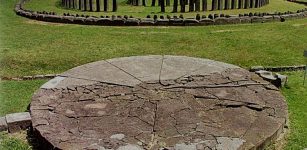 Sarmizegetusa And Its Andesite Sun Artifact Similar To The Mayan Calendar
Artifacts | Apr 13, 2021
Sarmizegetusa And Its Andesite Sun Artifact Similar To The Mayan Calendar
Artifacts | Apr 13, 2021 -
 10 Most Bizarre Forms Of Ancient Taxes: Surprising And Funny
Featured Stories | Nov 21, 2016
10 Most Bizarre Forms Of Ancient Taxes: Surprising And Funny
Featured Stories | Nov 21, 2016 -
 Humans Started Wearing Clothes 100,000 To 500,000 Years Ago
Ancient History Facts | Mar 17, 2018
Humans Started Wearing Clothes 100,000 To 500,000 Years Ago
Ancient History Facts | Mar 17, 2018 -
 Gryla: Cannibalistic, Evil Troll And Her Sons ‘Yule Lads’ – In Icelandic Folklore
Christmas Traditions | Dec 11, 2019
Gryla: Cannibalistic, Evil Troll And Her Sons ‘Yule Lads’ – In Icelandic Folklore
Christmas Traditions | Dec 11, 2019 -
 Sacred ‘Sign Posts’ Of The Inuit People
Ancient History Facts | Sep 4, 2018
Sacred ‘Sign Posts’ Of The Inuit People
Ancient History Facts | Sep 4, 2018 -
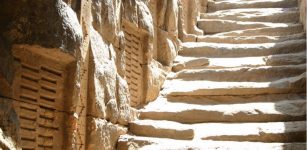 5,000-Year-Old Tradition Of Nilometer: Water Measurement Device From Pharaonic Times
Ancient History Facts | Jun 15, 2018
5,000-Year-Old Tradition Of Nilometer: Water Measurement Device From Pharaonic Times
Ancient History Facts | Jun 15, 2018 -
 The Face Of The Amarakarei – Remarkable Enormous Face Caved Into Stone Cliffs In Peru
Civilizations | Nov 20, 2015
The Face Of The Amarakarei – Remarkable Enormous Face Caved Into Stone Cliffs In Peru
Civilizations | Nov 20, 2015 -
 Ancient Ruins Of Kilwa Kisiwani And Songo Mnara: Great African Ports Long Abandoned And Forgotten
Civilizations | Nov 21, 2018
Ancient Ruins Of Kilwa Kisiwani And Songo Mnara: Great African Ports Long Abandoned And Forgotten
Civilizations | Nov 21, 2018 -
 Bones Of Giants Unearthed In Ancient Cave
Featured Stories | Sep 23, 2018
Bones Of Giants Unearthed In Ancient Cave
Featured Stories | Sep 23, 2018 -
 Khara-Khoto ‘Black City’ – Besieged By Genghis Khan But Flourished Under Mongol Rule
Featured Stories | May 13, 2021
Khara-Khoto ‘Black City’ – Besieged By Genghis Khan But Flourished Under Mongol Rule
Featured Stories | May 13, 2021 -
 How Did Vikings Celebrate Yule – The Winter Solstice?
Ancient Traditions And Customs | Dec 17, 2020
How Did Vikings Celebrate Yule – The Winter Solstice?
Ancient Traditions And Customs | Dec 17, 2020 -
 Bulla Felix: Legendary Italian Leader Of Outlaws Who Robbed The Rich And Gave To The Poor
Featured Stories | Mar 23, 2023
Bulla Felix: Legendary Italian Leader Of Outlaws Who Robbed The Rich And Gave To The Poor
Featured Stories | Mar 23, 2023 -
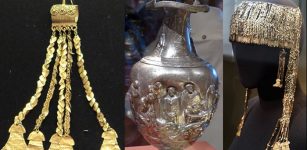 Priam’s Treasure – Authentic Trove From Homeric Troy Or Deception?
Artifacts | Jun 11, 2021
Priam’s Treasure – Authentic Trove From Homeric Troy Or Deception?
Artifacts | Jun 11, 2021

